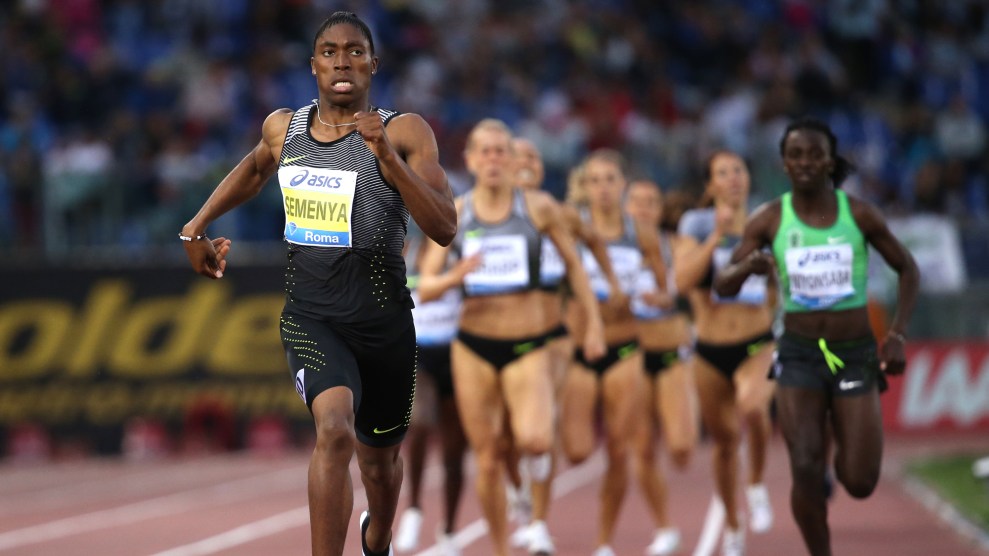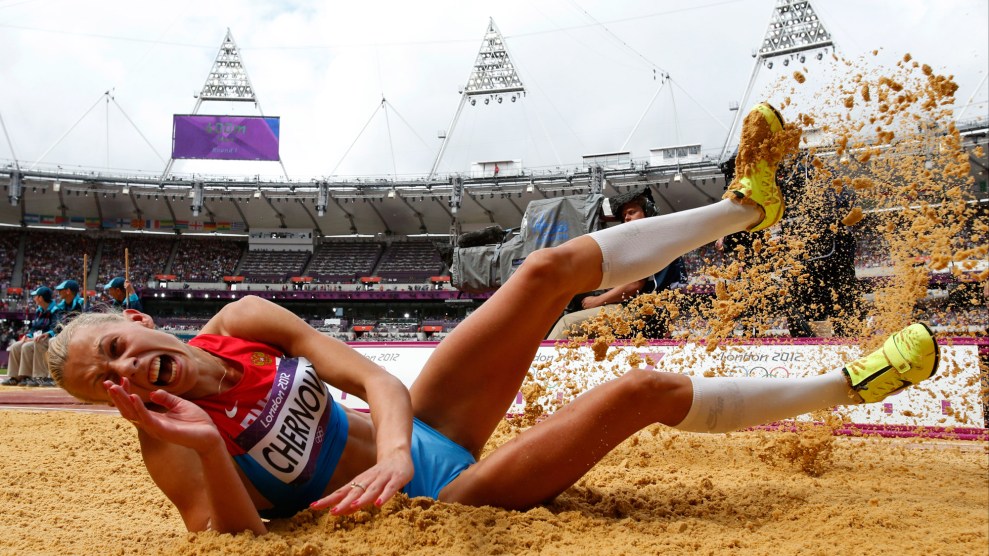
South Africa's Caster Semenya wins the 800-meter run at a competition in Rome in June 2016.Alessandro Bianchi/Reuters via ZUMA Press
Expectations are soaring for 25-year-old South African runner Caster Semenya, who races next week in the 800 meters. She’s favored to clinch a gold medal. She might even shatter the longest-running world record for track and field. And if she does, it could affect much more than the pride of her competitors. A big win for Semenya would likely add fuel to an already-fiery debate about gender and sports, and whether women like her should be allowed to race at all.
Semenya has an intersex condition, meaning her body doesn’t conform to typical notions of male or female. The South African runner produces testosterone at a level much higher than what’s found in most women, prompting questions about whether she has an unfair biological advantage. “These kind of people should not run with us,” Italian middle-distance runner Elisa Cusma said of Semenya back in 2009, after the South African was first publicly identified as intersex. “For me, she is not a woman. She is a man.”
For decades, the International Association of Athletics Federations (IAAF), the world’s governing body for track and field, has sought to preserve the male-female division in its sport through variations of sex testing—gynecological exams, chromosome tests, or hormone tests to make sure female competitors aren’t actually men trying to pass as women, or intersex women with masculine traits that might give them an unfair boost. Since 2011, sex testing has focused on testosterone. Women like Semenya whose functional levels of the hormone are within “the male range,” or higher than 10 nanomoles per liter of blood, have been barred from international competitions like the Olympics.
But not this year. For the first time in more than half a century, female Olympians will not be subject to any form of sex testing in Brazil, which means intersex track athletes will be allowed to compete with their natural testosterone levels. That’s because the IAAF’s testosterone rule was suspended last year by the Court of Arbitration for Sport, which said there was not enough scientific evidence to suggest that women with high levels of the hormone have a significant competitive advantage. The court gave the IAAF a deadline of July 2017 to come up with more evidence. If the athletic federation can do it, it can reinstate its rule, but otherwise the rule will be permanently void. (In February, the International Olympics Committee agreed to stop regulating women’s natural testosterone levels until the IAAF case is resolved.)
Now, as scientists struggle to determine how testosterone affects performance, thousands of athletes are converging on Rio de Janeiro for what some have described as a total “free-for-all,” as far as gender boundaries go. If Semenya dominates, will it be fair? What does the science say?
Testosterone, a hormone that’s been linked with increased muscle, bone mass, and competitive drive, is naturally found in both men and women, but the average man produces much more of it than the average woman does—a healthy young man can produce more than 35 nmol/L, while women usually produce less than 3 nmol/L.
Between 2011 and 2015, the IAAF had a rule that any woman with less than 10 nanomoles of testosterone per liter of blood could compete in women’s events—a cap that it said left plenty of wiggle room for almost all female athletes. But not everyone agreed. Last year, the Court of Arbitration for Sport suspended the IAAF’s “testosterone rule” after an Indian sprinter named Dutee Chand said it unfairly discriminated against women like her with higher levels. (Check out the New York Times Magazine‘s profile of Chand here.)
One of the main questions in Chand’s case was whether it made sense to create separate “male” and “female” ranges for testosterone, and whether 10 nmol/L was the appropriate threshold. Expert witnesses for the IAAF pointed to two large studies in Russia and South Korea showing that most elite female athletes had much lower testosterone levels, between 0.1 and 3.08 nmol/L. In fact, they added, 99 percent of female athletes had testosterone below 3.08 nmol/L. If anything, they said, the 10 nmol/L cap for women was “arguably too generous.”
But Chand, who will race the 100-meter dash at the Olympics on Friday, said plenty of women don’t fit neatly within that range, and that there’s overlap between the sexes. Testifying on her behalf, Richard Holt, a UK-based endocrinologist, pointed to a study showing that 32 of 234 female athletes had natural testosterone levels above 2.7 nmol/L, including 11 athletes who had more than 8 nmol/L. In the study of athletes in South Korea, he added, four male athletes had testosterone levels below 3.08 nmol/L, and 198 men had testosterone below 10 nmol/L. This type of data suggests there’s not necessarily a big gap between normal male and female ranges of the hormone, explained Dr. Katrina Karkazis, a bioethicist at Stanford University who also testified on Chand’s behalf.
However, Martin Ritzén, a Sweden-based professor who specializes in pediatric endocrinology and testified on behalf of the IAAF, said the probability of a healthy woman reaching 10 nmol/L of testosterone was “zero.” Another IAAF expert witness, Angelica Lindén Hirschberg, a professor of gynecology, noted that she had never seen such a high level of the hormone in someone with healthy ovaries and normal adrenal glands. Other expert witnesses told the Court of Arbitration for Sport that any healthy woman with more than 10 nmol/L of testosterone would likely have to be intersex. Still, Dr. Karkazis of Stanford criticized the threshold, which she said was based on the faulty premise that “men have the exclusive right to testosterone.”
Do women with higher levels of the hormone, like Caster Semenya and Dutee Chand, have an unfair advantage on the track? The IAAF says yes, in part because testosterone is linked with lean body mass, which experts on both sides of the debate say is a reason male athletes tend to perform better than female athletes. Testosterone leads to increased strength, speed, and power, IAAF experts argued, which is why many athletes try to illegally take synthetic versions of the hormone to boost their performance.
Ross Tucker, a professor of exercise physiology in South Africa, points to Semenya’s career as an example of natural testosterone’s effect. In 2009, before the public knew she was intersex, Semenya dominated the 800m race at the world championships in Berlin. Then the IAAF instituted its testosterone rule. Semenya was required to suppress her levels, and voilá: Her performance dropped off. Though she won a silver medal at the London Games (behind a Russian runner who has since been accused of doping), she failed to move beyond the semifinals in Beijing. After the testosterone rule was suspended in 2015 and she went back to her normal levels, she started dominating again. In April this year, she won the 400m, 800m, and 1500m races at the African Championships—all on the same day. “Now, she is untouchable,” Ross wrote recently.
We can also look to the performance of transgender female athletes, argues Joanna Harper, a doctor and transgender woman who has advised the International Olympic Committee on gender-based issues. Harper competed in male distance running events for decades, but when she started taking a testosterone blocker and estrogen as part of her transition, she became “noticeably slower,” she told the Court of Arbitration for Sport. Harper collated data from seven other transgender runners, too, for a study published in the Journal of Sporting Cultures and Identities, and found that all of them had “much slower times” competing as females than they had competing as males.
But other experts question whether it’s fair to equate the experience of trans women—who were born biologically male—with the experience of intersex women. “These are two different populations that don’t have comparable physiologies, so we can’t extrapolate from one group to the other,” Karkazis says. Yes, some intersex runners have lost speed after medically suppressing their testosterone levels, but Karkazis thinks other factors are at play. Drugs to suppress testosterone have side effects that affect metabolism and hydration, and that could slow an athlete down. A runner’s performance may also take a hit from the psychological toll of being outed to the world as intersex. “I have been subjected to unwarranted and invasive scrutiny of the most intimate and private details of my being,” Semenya wrote in 2010.
It’s not even clear whether natural testosterone boosts performance to the same degree that synthetic testosterone does. Holt, the UK-based endocrinologist, told the Court of Arbitration for Sport that “the current state of evidence regarding testosterone’s effects on athletic performance is ‘rudimentary.'” He said natural testosterone may affect a person’s lean body mass, but other things do, too, like high levels of human growth hormone in the body. What’s more, he says, plenty of other physical traits give advantages to athletes, and those aren’t regulated like testosterone is. Some basketball players are blessed with height, for example, while some swimmers are born with higher lung capacity and large hands and feet.
The IAAF argued with its rule that testosterone is the most important boost to athletic performance. But the Court of Arbitration for Sport wasn’t convinced. It came down to numbers. The average performance gap between male and female athletes is 10 to 12 percent. But IAAF experts were only able to present data—including some that had not been published—that showed a 1 to 3 percent performance difference between female athletes with higher testosterone levels and those with more typical levels. “While a 10 percent difference in athletic performance certainly justifies having separate male and female categories, a 1 percent difference may not justify a separation between athletes in the female category,” the Court of Arbitration for Sport wrote in its decision to suspend the IAAF rule. Other factors affect athletic power too, it noted, including things like nutrition, access to specialist training facilities and coaches, and other genetic factors. “In other words, there is presently insufficient evidence about the degree of the advantage” that women with high testosterone levels have, it wrote.
“Nobody is saying that testosterone is not relevant to performance. It is,” Dr. Karkazis says. But based on the scientific evidence, she says, “you can’t say women with higher testosterone levels will necessarily or always do better than women with lower levels. People are overdetermining testosterone’s effects in ways that don’t fit with what we know scientifically.”
The IAAF, which did not respond to a request for comment, will likely come forward within the next six months with more evidence to try to support its hormone-level-based policy. In the meantime, the world will look to Rio de Janeiro, as Semenya gears up for the race of her life.
Australian coach Nic Bideau predicts Semenya won’t have to push herself to take home gold. “When you’re watching it, clearly it’s not a fair competition, but the rules say it is fair,” he said recently. US middle-distance runner Brenda Martinez, who did not qualify for the 800-meter race but will compete in the 1,500 meters, has also said she believes Semenya should be forced to lower her testosterone levels for fairness’ sake. If women with high levels are allowed to race, will other women with more typical levels have any chance to win?
Dutee Chand, the Indian sprinter, counters that it’s unfair to make someone reduce hormone levels with medical intervention when it’s not medically necessary. “Other athletes have their own natural advantages,” points out Christopher O. Tollefsen, a philosophy professor at the University of South Carolina who has studied Semenya’s case. “She should not be penalized for hers.”
And as for Semenya? Asked last year about her prospects for an Olympic gold, she said, “That’s the ultimate dream.”
“I’m just being Caster, you know?” she said. “I’d rather just be natural, be who I am.”
This article has been revised.

















